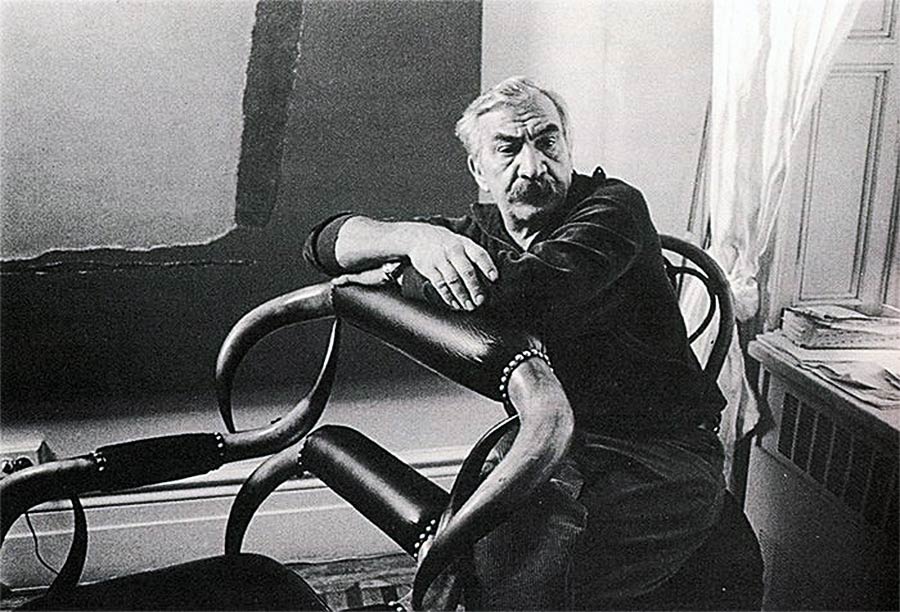Theodore Stamos
Theodore Stamos (1922-1997) was a significant figure in the American Abstract Expressionist movement, known for his evocative use of color and form. His works reflect a deep engagement with nature and spirituality, and his contributions to the art world have left a lasting legacy.

Early Life and Education
Theodore Stamos was born on December 31, 1922, in New York City to Greek immigrant parents. Growing up in the culturally rich environment of Manhattan, Stamos was exposed to diverse artistic influences from an early age. His father owned a small flower shop, and this connection to the natural world would later become a central theme in Stamos’s work.
Stamos’s artistic journey began in earnest when he enrolled in the American Artists School in New York. Although he initially studied commercial art, his interest soon shifted to fine art. The school’s progressive approach, emphasizing modernist techniques and ideologies, significantly influenced Stamos’s development as an artist. He was particularly drawn to the works of European modernists such as Paul Klee, Joan Miró, and Piet Mondrian.
Artistic Development and Abstract Expressionism
In the early 1940s, Stamos befriended several influential artists, including Arshile Gorky, Willem de Kooning, and Barnett Newman. These relationships were instrumental in shaping his artistic vision and integrating him into the burgeoning Abstract Expressionist movement. By the mid-1940s, Stamos had begun to develop his distinctive style, characterized by bold use of color and abstract forms.
Stamos’s early works often incorporated organic shapes and a vibrant color palette, reflecting his connection to nature. He was particularly fascinated by the interplay of light and shadow, which he explored through the use of contrasting colors and dynamic compositions. This period also saw Stamos engaging with themes of mysticism and spirituality, drawing inspiration from Eastern philosophies and Native American art.
Notable Artworks
- “Infinity Field, Lefkada Series” (1971-1974)One of Stamos’s most renowned series, the “Infinity Field, Lefkada Series,” was inspired by his visits to the Greek island of Lefkada. The paintings in this series are characterized by their expansive fields of color and serene, meditative quality. Stamos’s use of color in these works evokes the natural beauty of the island’s landscape, creating a sense of infinite space and tranquility.Notable Artwork: “Infinity Field, Lefkada Series, 1971-74” (1971-1974)This piece exemplifies Stamos’s mastery of color and form. The painting features a harmonious blend of blues, greens, and earth tones, reminiscent of the sea and sky. The subtle gradients and expansive composition invite viewers to contemplate the infinite and the sublime, capturing the essence of Stamos’s artistic vision.
- “Sun-Box” (1945)“Sun-Box” is an early work that showcases Stamos’s interest in organic forms and vibrant colors. The painting features a dynamic composition of abstract shapes and bold hues, creating a sense of movement and energy. The interplay of light and shadow in this work reflects Stamos’s fascination with the natural world and his ability to translate its essence into abstract terms.Notable Artwork: “Sun-Box” (1945)In “Sun-Box,” Stamos uses a palette of warm reds, oranges, and yellows, evoking the warmth and intensity of the sun. The abstract shapes seem to pulse with energy, suggesting the dynamic forces of nature. This work is an excellent example of Stamos’s early exploration of color and form, laying the groundwork for his later, more refined pieces.
- “Listening Hills” (1954)“Listening Hills” represents a transitional phase in Stamos’s career, where he began to explore more simplified forms and muted color palettes. This painting reflects his growing interest in creating a sense of depth and space through minimal means. The work’s serene, contemplative quality exemplifies Stamos’s ability to evoke profound emotions through abstraction.Notable Artwork: “Listening Hills” (1954)The painting features a series of overlapping, horizontal bands of color, creating a sense of depth and landscape. The subdued palette of blues, grays, and greens evokes a tranquil, meditative atmosphere. “Listening Hills” demonstrates Stamos’s skill in using color and composition to create a sense of place and emotion, even within an abstract framework.
Legacy and Influence
Theodore Stamos’s contributions to Abstract Expressionism and his exploration of color and form have left a lasting impact on the art world. His works are characterized by their emotional depth and spiritual resonance, reflecting his belief in the power of art to transcend the material world and evoke the sublime.
- Influence on Abstract Expressionism: Stamos was part of the first generation of Abstract Expressionists, a group that included Jackson Pollock, Mark Rothko, and Willem de Kooning. His work, with its emphasis on color and abstraction, helped to define the movement and expand its expressive possibilities.
- Impact on Color Field Painting: Stamos’s exploration of expansive fields of color and his ability to create depth and emotion through minimal means influenced the development of Color Field painting. Artists such as Helen Frankenthaler and Morris Louis, who were key figures in this movement, drew inspiration from Stamos’s innovative use of color and form.
- Continued Relevance: Stamos’s work continues to be celebrated for its beauty and emotional power. His paintings are held in major museum collections worldwide, including the Museum of Modern Art in New York, the Guggenheim Museum, and the Whitney Museum of American Art. His influence can be seen in the work of contemporary artists who explore themes of nature, spirituality, and abstraction.
Personal Life and Later Years
Despite his significant contributions to the art world, Stamos faced several personal and professional challenges throughout his career. He was deeply affected by the suicides of close friends and fellow artists Mark Rothko and Adolph Gottlieb. Additionally, Stamos’s involvement in the controversial Rothko estate trial in the 1970s, where he was accused of mismanaging Rothko’s works, cast a shadow over his later years.
Nevertheless, Stamos continued to create and exhibit his work, maintaining a deep commitment to his artistic vision. He traveled extensively, drawing inspiration from his visits to Greece, Italy, and other countries. These travels reinforced his connection to nature and his interest in the spiritual and mystical aspects of art.
Stamos passed away on February 2, 1997, in Ioannina, Greece, leaving behind a rich legacy of innovative and emotionally resonant artworks. His contributions to Abstract Expressionism and his exploration of color and form continue to inspire and captivate audiences worldwide.
Conclusion
Theodore Stamos’s artistic journey is a testament to his dedication to exploring the depths of color, form, and emotion. Through his innovative techniques and distinctive style, Stamos pushed the boundaries of Abstract Expressionism and left an indelible mark on the art world. His notable works, such as the “Infinity Field, Lefkada Series,” “Sun-Box,” and “Listening Hills,” exemplify his mastery of color and his ability to evoke profound emotions through abstraction.
In celebrating Theodore Stamos’s life and work, we recognize his significant contributions to modern art and his enduring legacy as a pioneer of Abstract Expressionism. His paintings continue to inspire and captivate, reminding us of the power of art to transcend the material world and touch the sublime.



